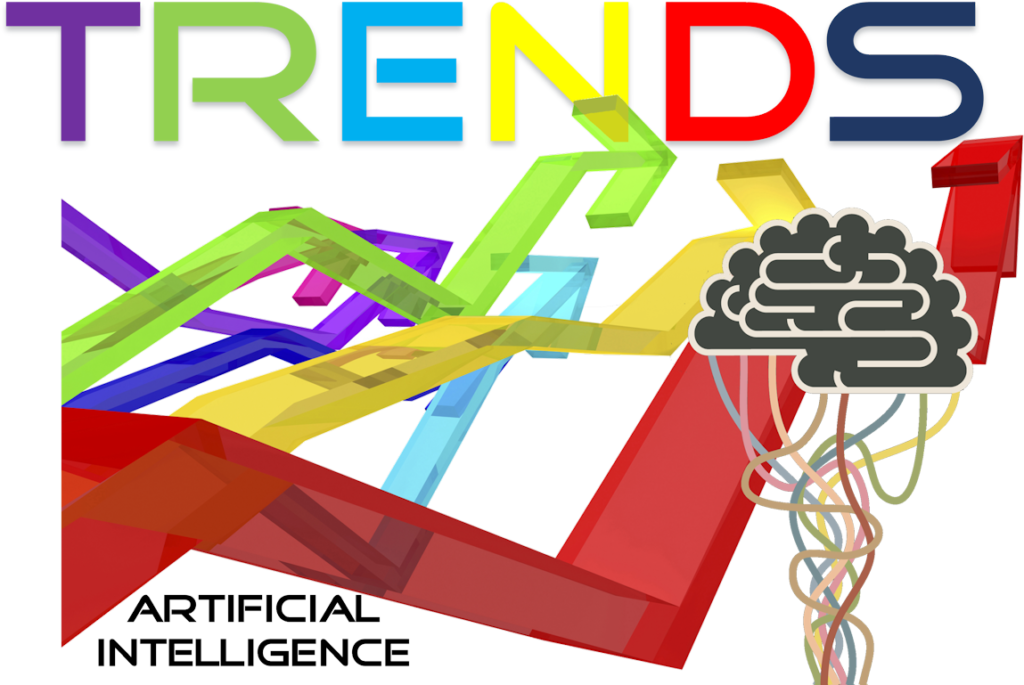Few technologies stir human emotions as much as artificial intelligence (AI). Some people anticipate great things happening thanks to AI, while others feel only deep anxiety about humanity’s future. Regardless of your feelings, 2023 was a breakout year for AI. Anders Billesø Beck, Vice President of innovation and strategy at Universal Robots, explains, “2023 was an exciting year for innovation. The emergence of artificial intelligence technologies, such as generative AI, captured global attention and dominated headlines. However, the adoption of generative AI for businesses is still very much in its early stages and questions around how best to harness this technology remain at the forefront of many minds. Digital transformation is an ongoing process so we can expect to see this year’s breakthrough trends continuing to shape society into next year.”[1] Below are a few of the trends experts have identified in the artificial intelligence field.
Artificial Intelligence Trends
Rise of the Prompt Engineer. As noted above, generative AI captured many headlines this past year. One of the oft-written about topics was AI hallucinations. Tech writer Oluwademilade Afolabi explains, “Artificial intelligence hallucination occurs when an AI model generates outputs different from what is expected. … A ChatGPT hallucination would result in the bot giving you an incorrect fact with some assertion, such that you would naturally take such facts as truth. In simple terms, it is made-up statements by the artificially intelligent chatbot.”[2] Simply stated, an hallucination is an AI lie. Srinivas Mukkamala, a computer scientist, AI expert and Chief Product Officer at Ivanti, explains that addressing AI hallucinations will be critical in the future. He states, “Data has been viewed as a trustworthy and unbiased way to make smart decisions. As we tackle the rise of AI-generated data, organizations will need to spend time and oversight validating the data or risk hallucinated results.”[3] One way experts have suggested dealing with hallucinations is using better prompts to generate answers. Nish Parikh, CEO and Co-founder of Rangam Consultants, explains, “[Generative AI] requires precise prompts and clear instructions to perform optimally. When it comes to honing self-learning skills, it becomes essential for individuals to first develop the ability to provide such prompts and instructions. When done right, there are endless possibilities to garner knowledge by training the brain on how to distill problems into their essence and think with clarity in order to find the best solutions.”[4] In other words, people skilled at asking the right questions will be in demand. Because artificial intelligence has the potential to make answers cheap, the value of questions — and the value of prompt engineers — is only going to climb.
Predicting the Future. Making predictions can be a fool’s errand; however, AI tools are making the cloudy crystal ball a bit clearer. Mario Mirabella, CEO of MSM Digital, writes, “AI-powered predictive analytics enables us to harness the power of data and uncover valuable insights that can drive business success. By analyzing vast amounts of historical data and leveraging advanced algorithms, AI can identify patterns, detect trends and make accurate predictions about future outcomes. Imagine being able to anticipate customer demand, optimize your supply chain and make informed decisions in real time. With AI, we can do just that. By leveraging predictive analytics, businesses can reduce costs, improve operational efficiency and enhance overall decision-making.”[5] Last year, Enterra Solutions® announced it had created an Enterprise Growth WarRoom™ capability for consumer products (CP) and retail companies. Enterra’s new Intelligent Agent-driven offering delivers a quantitative, system-based approach to driving growth, competitiveness, and resiliency for global organizations and addresses the need for increased agility within the CP and Retail market. It accomplishes this by analyzing the external factors impacting companies’ operations and developing system-generated recommendations for strategy development and execution. The first application of this new technology-led business management approach focuses on driving growth and profit through the levers of holistic revenue growth management.
AI-enhanced Automation. Beck predicts, “AI will set a new pace of development in robotics and automation. AI is transforming the world of software development, making it cheaper, faster and more effective. Software is a key component of automation, and with AI, software developers will be able to create more customized and optimized solutions for various tasks and challenges.” He adds, “It has been interesting and perhaps surprising to see AI changing the lives of office workers before it touches working practices in most factories. I look forward to seeing the benefits of machine learning reach more manufacturers in 2024. After all, the technology is already there. … With time, these capabilities will lead to unprecedented flexibility, quality and reliability in manufacturing.”
Employment Turmoil. One only needs to reflect on the angst globalization created in many developed countries to understand that AI is likely to create similar reactions. Parikh observes, “While AI might take over some jobs, it is also expected to create new job opportunities. Many current AI tools, including ChatGPT, cannot be fully relied on for context or accuracy of information; there must be some human intervention to ensure correctness.” Many experts see AI as “augmented intelligence” and way to enhance, rather than replace, human workers. That doesn’t mean, however, that some jobs won’t be taken over by AI systems. Mukkamala predicts, “2024 will spark more anxiety among workers about the impact of AI on their careers. For example, in our recent research, we found that nearly two out of three IT workers are concerned generative AI will take their jobs in the next five years. Business leaders need to be clear and transparent with workers on how they plan to implement AI so that they retain talented employees — because reliable AI requires human oversight.” Futurist Bernard Marr is one expert who falls within the augmented intelligence camp. He writes, “Envision AI as more than just an instrument; picture it as an invaluable ally. Imagine surgeons supplemented with AI-guided diagnostics during procedures, attorneys empowered by AI-curated case references mid-trial, or software developers aided by instantaneous, AI-propelled code suggestions. Additionally, as remote work and online education surge, AI stands poised to revolutionize tailored curriculum designs and optimize virtual team dynamics. 2024 heralds a symbiosis of human aptitude and AI prowess, amplifying both productivity and excellence.”[6]
Addressing Global Challenges. Although AI is likely to create some social challenges, it will also help the world address some global challenges — especially if quantum computing is perfected. Marr predicts, “As 2024 unfolds, we will see monumental leaps in AI capabilities, especially in areas demanding complex problem-solving fueled by quantum advancements.” Parikh insists AI models will help society address two interconnected challenges: climate adaptation and decarbonization. He writes, “AI can enhance climate modeling and prediction by analyzing vast amounts of climate data and identifying patterns and trends. Machine learning algorithms can improve the accuracy and granularity of climate models, helping us understand the complex interactions within the Earth’s systems. This knowledge enables better forecasting of natural disasters, extreme weather events, sea-level rise and long-term climate trends. As we look ahead, AI can enable policymakers and communities to make informed decisions and develop effective climate action plans. … AI can [also] optimize energy consumption and enhance the efficiency of renewable energy systems. Machine learning algorithms analyze energy usage patterns, weather data and grid information to improve energy distribution and storage. AI-powered smart grids balance supply and demand, reducing transmission losses and seamlessly integrating renewable energy sources. This maximizes clean energy utilization, reduces greenhouse gas emissions and lessens our dependence on fossil fuels.”
AI Regulation. Legislation and regulation always play a game of catch-up when dealing with technology. AI is no different. Nevertheless, 2023 saw significant movement in the area of AI regulation. Marr observes, “As 2024 beckons, leading nations, including China, the EU, the U.S. and India, are diligently sculpting comprehensive AI policies. Their objectives are three-pronged: to catalyze technological breakthroughs, magnetize global investments, and concurrently safeguard their populace from any inadvertent AI repercussions. Conversations within the industry hint at potential international synergies, suggesting that global collaboration on AI benchmarks and norms could soon materialize.”
Singularity? Looking ahead numerous experts see a time when AI systems become so smart we don’t honestly know how they will affect the future. As I noted earlier, this so-called singularity is the source of both anticipation and anxiety. Technologist Anirudh Mantha writes, “The rise of superhuman AI … could revolutionize content creation, code generation, and scientific discovery.”[7] At conference held last fall in Bellevue, WA, futurist Ray Kurzweil doubled down on his prediction that the singularity is not far off. He told the audience, “By 2029 AI will pass the Turing test, and by 2045 it will reach a ‘singularity’.”[8]
Concluding Thoughts
Mirabella concludes, “The future of AI is bright, and with the right approach, we can benefit from the advancements in AI technology while also tackling its challenges.” Bill Gates also sees a bright future for artificial intelligence. He asks, “When you think back on 2023, how will you remember it?”[9] One of the things he will remember is that 2023 “gave us a glimpse of how AI will shape the future.” He adds, “We are just at the beginning of this transition right now. This is an exciting and confusing time, and if you haven’t figured out how to make the best use of AI yet, you are not alone. … There’s no question these are challenging times, but I remain optimistic about the future.” Why is he so optimistic? He writes, “AI is about to supercharge the innovation pipeline.” I’m also optimistic about the future and the role that artificial intelligence will play in making the world a better place.
Footnotes
[1] Anders Billesø Beck, “Four Predictions for 2024: AI Set to Supercharge Robotic Automation,” Automation.com, 20 December 2023.
[2] Oluwademilade Afolabi, “What Is AI Hallucination, and How Do You Spot It?” Make Use Of, 24 March 2023.
[3] Ian Krietzberg, “AI trends: What experts, execs think artificial intelligence will look like in 2024,” TheStreet, 20 December 2023.
[4] Nish Parikh, “Exploring the Future of Artificial Intelligence — 8 Trends and Predictions for the Next Decade,” Entrepreneur, 10 July 2023.
[5] Mario Mirabella, “The Future Of Artificial Intelligence: Predictions And Trends,” Forbes, 11 September 2023.
[6] Bernard Marr, “The 5 Biggest Artificial Intelligence Trends For 2024,” Forbes, 1 November 2023.
[7] Anirudh Mantha, “5 most exciting developments in artificial intelligence for 2023–2024 and beyond,” Medium, 13 December 2023.
[8] Casey Luskin, “Ray Kurzweil Predicts: The ‘Singularity’ by 2045,” Evolution News, 8 November 2023.
[9] Bill Gates, “The road ahead reaches a turning point in 2024,” Gates Notes, 19 December 2023.





